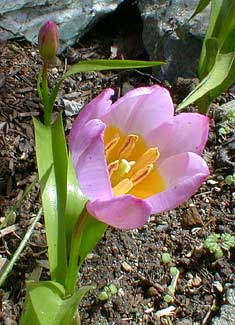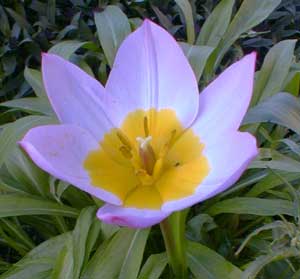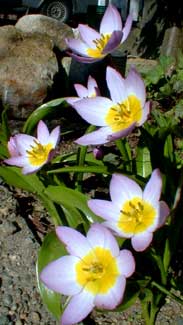 'Lilac Wonder'
'Lilac Wonder'
Baker's Tulip
"A tulip!" cried the furious old man.
"A tulip! That symbol of pride & lust!"
-The Tulip Vendor,
by Aloysius Bertrand
(1807-1841)
by Aloysius Bertrand
(1807-1841)
I just so much prefer little species tulips over gaudy big hybrid cultivars. Tulipa bakeri 'Lilac Wonder' begins to poke its leaf-nose out of the ground in late December or in January, & can bloom as early as the end of March, though never later than the first week of April, lasting the whole month of April.
Baker's Tulip is a common wildflower on the island of Crete. It was named after G. P. Baker of the Royal Horticultural Society, who introduced it through the Society in 1895.
Some authorities believe T. bakeri is only a variant of T. saxatilis undeserving of its own species name, though they have sufficiently distinct chromosome signatures that they have not to date been combined taxonomically.
 The selected variety 'Lilac Wonder' is the most common Baker's Tulip offered to western gardening. The wild form is a more subdued yellow & mauve, & smaller than the more colorful 'Lilac Wonder,' hence not as popular, though sometimes available from specialists.
The selected variety 'Lilac Wonder' is the most common Baker's Tulip offered to western gardening. The wild form is a more subdued yellow & mauve, & smaller than the more colorful 'Lilac Wonder,' hence not as popular, though sometimes available from specialists.Due again to the close similarity of T. bakeri & T. saxatalis, 'Lilac Wonder' was initially categorized as a color variant of T. saxatilis, being a bit larger than wild specimens of T. bakeri. But the registraiton committee found that it had the chromosomes of T. bakeri.
This specific selected variety was introduced to gardening in 1971 by Kees Visser, who obtained the initial bulbs from Gerald H. Hageman of the International Flower Bulb Center (Internationaal Bloembollen Centrum) in Hillegom, The Netherlands.
 It grows to only about eight inches tall at most, with beautiful big cup-flowers that are pastel lilac on the outside & on the inner tips, & brilliant yellow at the heart. The leaves coil backward slightly, remaining close to the ground.
It grows to only about eight inches tall at most, with beautiful big cup-flowers that are pastel lilac on the outside & on the inner tips, & brilliant yellow at the heart. The leaves coil backward slightly, remaining close to the ground.It loves full sun with moist soil while it is growing in spring, dry in winter. They naturalize very easily. Our first little patch began with ten bulbs. The ones shown in the first & second photos on this page are blooming at foot of a Wentworth Cranberry by the back porch.
These were the first ones we planted (in Autumn 2002). Under the cranberry viburnum they get only afternoon sun, probably a little less of that than would be ideal, yet they have bloomed wonderfully in Aprils 2003 & 2004.
As the cranberry gets bushier the tulips are bound to end up with even less sun, by which time it may be necessary to lift & divide the bulbs anyway, & then I'll decide whether or not I need to find a sunnier spot for them.
In the meantime, we've already planted nine more 'Lilac Wonder' bulbs in a sunny streetside garden at the foot of the 'Aphrodite' Rose of Sharon, mixing them in with little 'Sundisc' Jonquils. The second photo is one of the tulips abloom in this sunnier location.
'Sundisc' likes to have its bulbs planted a little deeper than the tulips (up to eight inches deep measuring from the bottom of the bulb) so that 'Lilac Wonder' can be layered above them at only four inches depth.